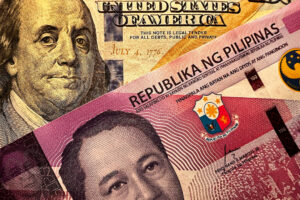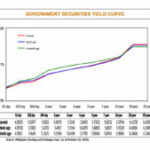
TeaThe cap is that the peso is very strong compared to other currencies. This means that our exports are less price-competitive in the global market, and imports are cheaper and easier to find. Yes, even at P58 to $1.
I rest my case on the following grounds:
1. US President Trump has imposed a 19% tariff on Philippine exports to the USSimilar to those imposed on other countries such as Vietnam (20%), which is the US's fourth largest exporter, and whose trade surplus with the US reaches $123 billion. The peso has hardly weakened since then to compensate for tariff barriers.
2. Traders are continuously incurring losses. Manufacturing continues to decline as a share of GDP due to the strong peso. Manufacturing share in GDP to decline from 16.2% to 15.7% in 2023. More telling is that the Philippines' manufacturing share of GDP is slightly ahead of Brunei, Laos, and Mongolia, and well behind Cambodia (27.8%), Thailand (24.3%), and Indonesia (19.0%).
What's worse is that 55% of our exports are manufactured electronics, which is highly import-intensive. As a result, our biggest import is also electronics. The strong peso continues to discourage backward integration.
The Philippines is deindustrializing, a phenomenon described by national scientist Dr. Raul Fabela as “developmental progeria” or “premature aging”, where services dominate the economy, primarily due to the strong currency. The problem is that these services are low-end services ranging from retail to fast food, not high-end services such as financial services as in Singapore.
Additionally, high-paying entry-level jobs are in manufacturing. A shrinking manufacturing sector means fewer high-paying blue-collar jobs.
As the United States found out during Covid, manufacturing matters for national security. Even simple items like masks had to be imported from China. This is why US President Trump is imposing high tariffs on imported goods to force companies to set up their manufacturing within US shores.
3. As further reFEstimates of our loss in export competitiveness, The number of Philippine exporters has declined significantly, from about 6,000 firms to about 4,000 firms, according to a newspaper report. Trump tariffs and rising labor costs will further reduce those numbers.
4. Our tourism numbers are the worst in the whole of ASEAN. The number of tourists to the Philippines from January to August was just 3.96 million, compared to 13.9 million in Vietnam and 28.4 million in Malaysia. No, the modest tourism numbers are not due to our West Philippine Sea dispute with China. The truth is that traveling to the Philippines is expensive. In dollar terms, the overall travel experience – food, hotels, transportation, shopping and services – is about 20% to 30% more expensive in the Philippines than in Vietnam and Thailand.
Do exchange rates matter in the tourism industry? Just look at Japan. Since the Japanese Yen weakened following the pandemic, Japan has seen tourism numbers surge, so much so that their citizens are complaining of “overtourism.” And no, it's not just the safety, cleanliness and culture in Japan that are attracting tourists. They existed in previous decades, but tourism boomed only when the yen declined sharply.
5. Vietnam's share of Japan's banana market is increasing at the expense of the Philippines. The volume of exports from Vietnam to Japan is expected to increase fourteen-fold from 2019 to 2024, mainly due to improved price competitiveness. I spoke to a banana exporter, and he admitted that it has become harder to maintain market share in Japan due to rising costs (mainly labor) and the strong peso.
6. In 2010, the Philippine peso and the Indian rupee were worth 45 to 1 dollar. Today the Philippine peso is at P57 to $1 while the Indian rupee is at 88 to $1. This has an impact on the price competitiveness of our BPO sector. The Philippines cannot continue to rely on its workforce's familiarity with American culture and lack of thick accents to advance its BPO.
Furthermore, Philippine BPOs face geopolitical and technological constraints. AI is threatening to displace a large number of BPO jobs. The US Congress is threatening to punish US companies that outsource call center jobs. Philippine BPOs lack the margins to weather these headwinds.
7. Create More* Philippine FDI remains at a low level of $8.9 billion despite legislation and liberalization measures. Such as Public Service Act and foreign ownership liberalization in renewable energy. Why? Because the dollar cost of doing business in the Philippines remains high. Lack of infrastructure, high power costs, high labor costs and bureaucratic red tape and corruption are cited by investors as reasons for staying away. But there is a more fundamental reason – these problems are not offset by the dollar cost of doing business in the Philippines. Salaries and logistics costs are higher in dollar terms given the strong peso. So, why would investors come to the Philippines to produce for the foreign market when the cost of the dollar is high and export prices are not competitive?
It has been argued that the Philippine exchange rate reflects the market rate and that inflation remains low enough that the real exchange rate (exchange rate adjusted for inflation) is competitive. However, the flaw in that argument is that the exchange rate does not reflect the high cost of doing business in the country. There is a difference between the inflation rate in the country and the high cost of doing business.
Due to the country's history of overvaluing its currency, it is vulnerable to external shocks. According to Bank of America, the Philippines' external position is the weakest in Southeast Asia, with its current account deficit continuing to decline. Our trade deficit is huge at $57 billion. Service income from BPOs and OFW remittances offset the deficit. However, a sharp decline in BPO revenues or exports due to the Trump tariffs could prove destabilizing for the economy.
Due to its high foreign exchange reserves, the Philippines does not face an imminent foreign exchange crisis. However, it is still vulnerable to a shock, or painful adjustment, which could come in the form of sharply lower growth in the coming years (it is already much lower at 5.5% per annum than the government's projected 6% per annum) and high external debt.
Another painful adjustment will come in the form of higher unemployment, especially among the college-educated. CHED Chairperson Shirley Agrupis said the latest labor force survey already shows rising numbers of unemployed among the college-educated. The problem could get worse if the manufacturing sector continues to decline and BPOs reduce hiring. Rising youth unemployment due to public works corruption scandals could prove a powerful addition to growing political unease.
In other countries, rising currency is a cause for panic. Thailand's monetary authorities are struggling to stem the talk of depreciation. The Trump administration in the US is trying to weaken the dollar to reduce its trade deficit. This is why the Trump administration wants to control the US Fed. (Writings by Trump's chief economic adviser Stephen Mirant suggest that the US goal is to devalue its currency.) Here, hard money and a strong peso are celebrated.
In 1997, I and a few others – the late NEDA Secretary Cayetano Paderanga, Jr., National Scientist of Economics Raul Fabela, and Monetary Board member Dr. Benjamin Diokno – were called “jukebox economists” for drawing attention to peso overvaluation before the Asian financial crisis. Am I experiencing déjà vu?
* Corporate recovery and tax incentives for enterprises to maximize opportunities to revive the economy
Calixto V. Chikiamco is a member of the board of IDEA (Institute for Development and Econometric Analysis).
totivchiki@yahoo.com










